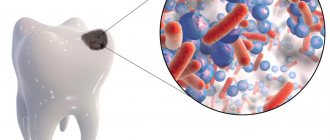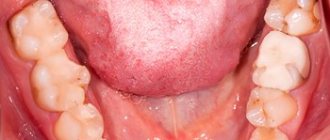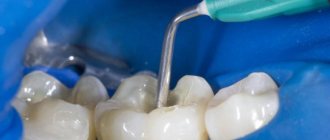There are a huge number of diseases in dentistry that can be cured only by removing problematic teeth. Many patients are mistaken in believing that a tooth is just a bone, the diseases of which cannot cause serious complications to the body. In fact, the tooth has a complex structure: it consists of a hard enamel layer, loose dentin and a neurovascular bundle. The infection can spread through the dentinal tubules into the dental pulp, where the nerves and blood vessels are located. When it is damaged, the tooth begins to hurt severely.
If treatment is not started in time, periodontitis (a connective tissue disease) develops, which is accompanied by the collapse of the neurovascular bundle. In this clinical situation, the concentration of pathogenic microflora in the canal increases. If endodontic treatment is delayed, the infectious process spreads to the periapical area, and from there to the bone. In this case, serious damage to the bone material is observed with a violation of its integrity. When the bone is severely degraded, the teeth become loose and unsupported and eventually have to be removed.
The inflammatory process can spread from one dental unit to others, leading to their infection. Most often, this situation occurs with periodontal disease. If left untreated, all neighboring teeth will become infected and it will be impossible to cure them.
The dentists at Dr. Granov’s clinic always try to preserve the patient’s teeth, but if this is not possible, they advise removing the diseased teeth.
Delete cannot be left
“The smart ones remove wisdom teeth,” many Russian dentists say. They are sure that it is best to get rid of eights during the period of change in bite, when the jaw bones have not yet “increased” sufficient density.
But so far this opinion is not shared by everyone, and opponents present well-founded arguments. The main one is the possibility of using the “sage” as a support for a bridge.
Most often, wisdom teeth are removed if they are incorrectly positioned and have difficulty erupting. For various reasons, they grow inside the jaw bone and may never overcome the gum barrier. The operation to extract such teeth is quite difficult, and it is recommended to do it in maxillofacial surgery.
Wisdom teeth are no different in appearance from other molars. They have the same crown and developed roots, but functionally they are far behind the sixes and sevens. Eights practically do not participate in the chewing process and serve only as a kind of fence that protects the dentition from divergence and loosening.
In 8 out of 10 patients, wisdom teeth cause problems with eruption.
Contraindications
- absence of sixes and/or sevens in the dentition;
- correct placement in the jaw, not harming neighboring teeth;
- the possibility of conservative treatment of figure eight;
- loosening of neighboring units, which require a figure eight to splint.
In Russia, it is considered advisable to preserve wisdom teeth, if possible. Their removal is postponed for as long as possible, although most often they have to come back to it again.
Even if a wisdom tooth is treated and the canals are filled, it does not “live” for long. The reason is the inconvenient location, which complicates hygienic care. Food plaque accumulates on the enamel, and the tooth quickly deteriorates.
Content
- There are two types of extraction
- How many teeth can be removed at once?
- Conclusion
A diseased tooth cannot always be treated. Patients often put off going to the dentist for various reasons. Such actions trigger destructive mechanisms in dental tissues.
Due to lack of treatment:
- Caries transforms into pulpitis;
- Further - into periodontitis, which is accompanied by cysts, fistulas and granulomas;
- The likelihood of developing periostitis of the jaw increases.
In case of high risks, the only correct solution is tooth extraction.
Such an outcome is always undesirable for the patient, because the next stage becomes another problem - the need for prosthetics.
Doctors always make every effort to save teeth, but this is not always possible. It happens that several teeth must be removed at once.
PROMOTION
Inexpensive tooth extraction
from 1000 rub.
Features of complex operations
Removing eights becomes more difficult if:
- location on the lower jaw. The lower teeth have a more massive and developed root system, and higher jaw bone density;
- tooth growth at an angle to the dentition or in a horizontal direction;
- incomplete eruption;
- tortuosity, entanglement of roots, especially when there are many of them;
- proximity of neighboring units, making it difficult to remove the figure eight;
Complex removals can be performed not only under local anesthesia, but also with sedation. Painkillers are administered together with sedatives and are selected individually. Operations under sedation provide psychological comfort and painlessness.
There are two types of extraction
Planned removal is prescribed if:
- A diseased tooth cannot be cured;
- The patient has a growth pathology - the tooth is positioned incorrectly, injures the tissues in the oral cavity or interferes with nearby teeth;
- The crown of the tooth is completely destroyed.
Emergency extraction is performed if the patient:
- Purulent periodontitis – acute inflammation develops in the periosteum;
- There is a process of bone destruction due to jaw osteomyelitis.
Signs of periostitis are:
- Throbbing sharp pain;
- Temperature increase;
- Edema.
In such cases, you cannot take measures on your own. Rinsing and warming up will not only not help, but will also worsen the situation.
Modern anesthetic drugs allow tooth extraction to be performed without pain. Anesthesia can be carried out in stages: first, the surface of the gums is covered with gel, and only after that the main anesthetic is administered.
Removal varies in difficulty. In any case, the tissues of the oral cavity are injured and complications are possible. Manipulation requires the professionalism of a dentist.
Easy removal
If the above features are not present, then the removal of the figure eight is carried out in the usual way. The total time of the procedure is about half an hour, but the tooth itself is removed quickly - in about 10 minutes. The rest of the time is spent on preparing and suturing the wound (if necessary).
The standard algorithm is:
- The dentist questions the patient about existing diseases, drug allergies and general health.
- Based on the data obtained, an anesthetic and sedative agent are selected.
- An anesthetic injection is given, and after it begins to act, the doctor begins to remove the eighth tooth.
- The tooth is loosened using forceps and removed from the jaw in one motion.
- Medicine or plasma membrane is placed in the socket to prevent inflammation and promote healing.
- If necessary, stitches are applied. This is usually required when removing the bottom eights.
Simple removal very rarely causes complications and is quite easily tolerated.
When should a wisdom tooth in the lower jaw not be removed?
There are no absolute contraindications to removal, but there are relative ones:
- The figure eight does not need to be removed if it is correctly positioned, functions and does not injure surrounding organs;
- The operation cannot be performed without preliminary preparation if the tooth is located in the area of the tumor or puts pressure on a large vessel or nerve;
- For some diseases, it is necessary to prepare the body for surgery (rheumatism, diabetes, blood diseases, etc.)
You can carry out high-quality removal of a wisdom tooth of any complexity at the Berezka dental clinic. Specialists perform various surgical procedures effectively, safely and painlessly. All manipulations are carried out professionally and taking into account the individual characteristics of each patient.
Removing 4 eights in one session
Removing all the sages at once can be a very reasonable and rational decision for certain indications. Most often, one-stage extraction is carried out for orthodontic indications, when it is necessary to install braces or corrective aligners.
The main advantage of such surgical treatment is the uniform and symmetrical movement of dental units due to the voids formed in the jaw in place of the sockets. After about 2 months, the sockets are overgrown with new bone, and the teeth can no longer move as easily and quickly. Thus, the duration of treatment by an orthodontist is reduced.
If removal is carried out for other indications, then this also has its advantages:
- When teeth are crowded, they move apart, thereby aligning the dentition. Otherwise, the doctor may recommend wearing special aligners to contain the process, in order to avoid the formation of large interdental gaps in the row;
- manipulations are performed by two dental surgeons in an average of 1 hour;
- anesthesia or sedation is carried out once, and not several times, if you part with the eights in turn;
- It is enough to take antibiotics only once instead of four times, which is especially important for chronic diseases;
- discomfort, pain and inconvenience when eating also will not have to be experienced twice.
How often can teeth be treated using sedation therapy?
Until now, many patients and even doctors are afraid of everything that is in one way or another connected with anesthesia, because previously heavy drugs with a lot of side effects were used for this. But since then, everything has changed dramatically: a huge amount of research has been carried out, many new medicines have been released. Today, anesthesiologists use the latest generation of drugs that have virtually no side effects; their contraindications are limited to the third and first trimester of pregnancy, lactation, as well as banal intolerance, which can even occur with aspirin.
All 4 at once: arguments against
Despite the current practice, when during 1 visit you can part with only one, maximum two teeth, there are no restrictions on the number of teeth removed. It all depends on the specific case, and there are contraindications.
For example, if a wisdom tooth is to be cut out, then multiple removals are not performed due to severe damage to the gums. A wound that is too large will make the recovery period more difficult and longer.
4 eights at the same time cannot be extracted in hypertensive patients and those who take anticoagulants - blood thinning drugs. These patients have an increased risk of major bleeding.
Sometimes it is necessary to inject a large volume of anesthetic in order to effectively numb the surgical sites. But there are certain limits beyond which you cannot go. If the required amount of anesthetic exceeds the permissible level, then several interventions are performed, not just one.
There are no problems with the anesthetic when removing two adjacent teeth in a row: in this case, it is not necessary to chip the jaw in several places.
Another reason for refusing multiple removals is the patient’s reluctance to experience significant difficulties during the rehabilitation period. After extraction of 4 teeth, pain will occur in 4 places, and in the first days the pain can spread to all jaws. But a number of patients, on the contrary, strive for just this option, preferring to “get over it” once and for all.
The extraction of all 4 wisdom teeth is also not carried out in case of severe inflammation of the gums, as this can provoke a large-scale inflammatory process.
Bleeding
If bloody discharge appears from the socket of an extracted wisdom tooth, you should call your doctor and report the situation. Minor gum bleeding can occur due to tissue injury, high blood pressure, or problems with blood clotting. In most cases, this does not threaten health and goes away on its own. If bleeding is severe or frequently repeated, you should inform your doctor and come for an examination. To prevent complications, you should rest more for several days, avoid physical activity, and monitor your blood pressure.
Pain in the socket
Everyone experiences pain after removal surgery and worries for several days. The intensity of pain will depend on the traumatic nature of the operation and the complexity of the surgical interventions. During the postoperative period, the dentist recommends using painkillers. If the pain does not disappear, but intensifies after 3-4 days, this may indicate complications. A professional examination and consultation with a doctor are required.
Rehabilitation
During the recovery period, dentists prescribe a course of antibacterial therapy and painkillers for the shortest possible course. That is, you should take analgesics as long as the pain persists. Most often, non-steroidal anti-inflammatory drugs based on ibuprofen and nimesulide (Nise) are prescribed for pain, which effectively relieve both pain and inflammation.
Antihistamines are prescribed to prevent generalized swelling in the area of the tooth socket.
It is highly advisable to quit smoking: nicotine interferes with the normal blood clotting process and can cause bleeding.
To speed up wound healing, it is recommended to rinse your mouth with antiseptics and eat liquid and soft foods for several days.











